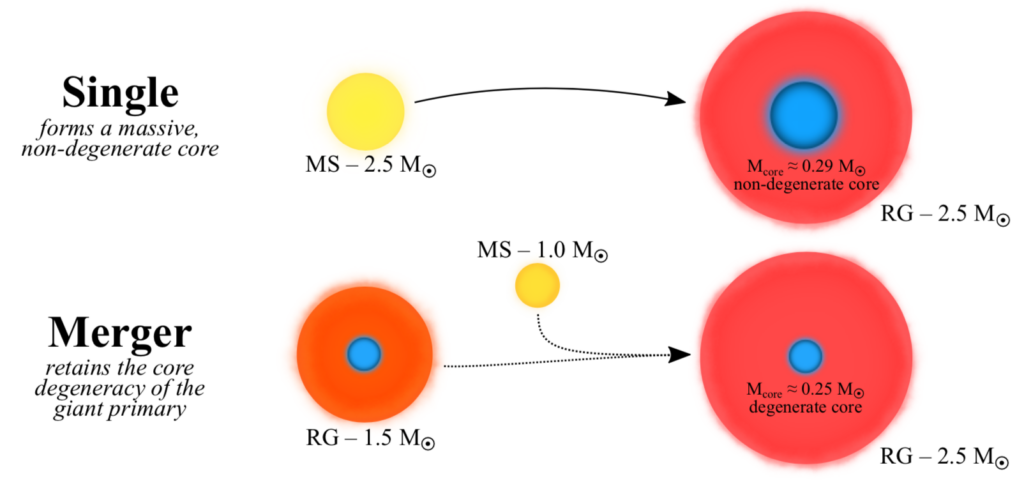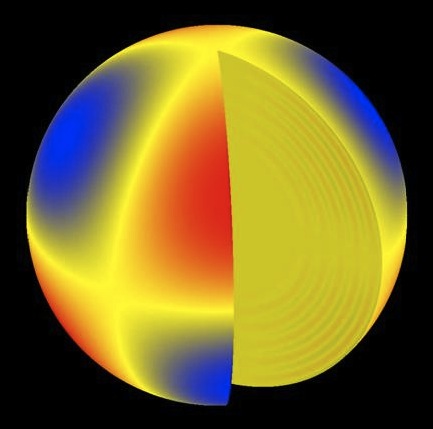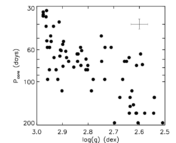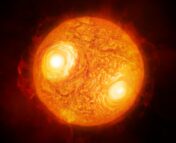Title: Asteroseismic Fingerprints of Stellar Mergers
Authors: Nicholas Z. Rui, Jim Fuller
First Author’s Institution: California Institute of Technology
Status: Submitted to MNRAS [open access on arXiv]
Burning red (TS, Red)
Just like humans on Earth, the stars exhibit a life cycle: they are born young and beautiful, live their lives burning different elements, and then die. Just like humans, stars can interact with other stars. Today’s story is all about very old stars – those that are almost ready to die, which we call red giants – and their interaction with other stars, which (in this context) we call mergers. Stars spend most of their lives on the main sequence; when they become red giants, they are not on the main sequence anymore.
The mergers in the context of stars have fatal outcomes – one of the stars completely disappears in the arms of the star it merges into. However, its disappearance leaves detectable signatures: bright starlight, and we might also see signs of the merger in the surviving post-merger star, e.g. an increase in luminosity. The authors of today’s paper investigate the situations in which we can or cannot see if the star has undergone a merger. They found 24 potential candidates of stars that had undergone a merger.
What’s past is past (TS, Begin again)
Astronomers have found ways to detect the most important properties of stars: their size, shape, and distance away from us. Now, using asteroseismology, we can also learn about “earthquakes” on the surfaces of stars – appropriately called starquakes. Imagine that a star is breathing: asteroseismology helps us to identify how frequently it takes breaths and how loud these breaths are. Knowing how a star breathes, we can learn about its interior structure and potentially say something about its history! This is the motivation behind today’s paper: using asteroseismology, the authors study if a star is the final outcome of a merger with another star. The important parameters that they use in the study are the frequency of the breaths and a frequency of maximum power, which tell us about the total mass and radius, and the period spacing, which tells about the core structure and retains information about the star’s evolutionary history, which can be used to identify merger remnants.
I can’t decide if it’s a choice getting swept away (TS, Treacherous)
The model that the authors focus on is a merger between a red giant and a main-sequence star (RG+MS) with masses of 1.5 solar masses and 1 solar mass (1.5+1), respectively (see Figure 1). They compare the final outcome of the merger with single stars of 1.5 solar masses and 2.5 solar masses. You would expect that after the 1.5+1 merger the final mass of the star would be 2.5 solar masses, in which case the red giant just gets fatter and adds 1 solar mass to its total mass, but it is not that trivial! Apparently, the degeneracy (a weird nature) of the stellar core and time of the merger play key roles here.

In Figure 2, you can see what different parameters (frequency, frequency of maximum power, period spacing, mass of a core) can really tell us about the mergers. The merger for MS+RG occurs at a value of 1 on the x-axis – the time when the primary star is not on the main sequence anymore. So, everything before 1 is pre-merger, and everything after 1 is post-merger. It is shown in Figure 2 that the merger remnant of a 1.5-solar-mass star and a 1-solar-mass star almost perfectly shows the same frequency as a single star with a mass of 2.5 solar masses (left panel). Conversely, the interior core structure of the post-merger remnant appears to be the same as that of a 1.5-solar-mass star — as if the merger never happened (upper right panel)! The authors explain this by claiming that the initial core of a pre-merger 1.5-solar-mass star is already degenerate, so it doesn’t care about any additional mass falling onto it. In addition to the core structure, on the lower right panel, it is shown that the mass of the core also doesn’t change after the merger, which suggests that the whole mass of the absorbed star goes into the envelope (or atmosphere) of the dominant star.
On the other hand, for MS+MS mergers the picture is slightly different. If the more massive star is still on the main sequence, its interior structure appears to be the same as that of a single star of the same mass! Indeed, looking later at the core structure for the “early merger” case (when the primary star is still on the main sequence) the authors see that the interior structure is indistinguishable from a single star of the same mass.

The authors also find that if a star has a mass less than or equal to 2 solar masses, it will evolve into a red giant with an already degenerate core, which is an important threshold because this way the degenerate-core red giants can be distinguished from more massive stars with non-degenerate cores. However, mergers that occur when the dominant star is on the main sequence are hard to identify because the final star’s structure is nearly indistinguishable from a single star of the same mass.
Mosaic broken hearts (TS, State of Grace)
Using all the information that the authors acquired in this study, they identify 24 candidates of red giants of masses greater than 2 solar masses that could be outcomes of a merger! The hint that helped them to identify these candidates was actually the core structure of an already developed degenerate core of a red giant – this is where these 2 solar masses come into play!
Though this paper already looked at a large number of different stellar parameters, there’s so much that can still tell us more about the evolution of red giants, like their magnetic fields or their rapid rotations. So, maybe these properties will be the topic of study in the near future!
Astrobite edited by Ryan Golant
Featured image credit: @yourhoebrian on Twitter




